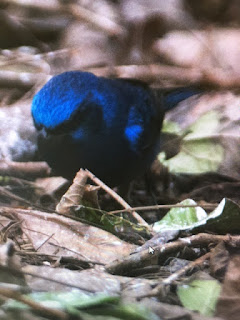
Well, . . . this is it!!! Another rare bird from Mexico, that sporadically comes up across the border, and into the Lower Rio Grand Valley of Texas. Thankfully, this one has been seen at Quinta Mazatlan in McAllen for almost 30 days. It was coming into the feeders at the station, once all the Red-Wing Blackbirds would leave.
The blue bunting (Cyanocompsa parellina) is a species of passerine bird found in Central America. Like most buntings, the blue bunting is sexually dimorphic. The male has a dark blue body, with brighter blue highlights on the supercilium, forecrown, malar region, rump and lesser wing coverts. The female is an unstreaked warm brown, slightly paler below.
 |
| 8am, waiting at the station w others |
Take a watch at my sweet video of this bird and experience. Loving my Canon SX60 camera.
https://www.youtube.com/watch?v=jzoJ7Jx6gGo
In 2018, this was the 3rd time I've seen a Blue Bunting. My first time(lifer) was back on April 4,1988 at Bentsen SP when I visited during spring break that year. I was 11. So I don't really remember it, but I'm sure it was a big deal, and probably the brown female bird. Then, lucky in 2016, another male Blue Bunting was reported at Frontera park in Weslaco, Tx. Luckly, while waiting on a trail for 20 minutes, we saw leaves moving on the ground, and we looked, then BAMM . . . see below.
 |
| 2016 bird at Frontera |
 |
| Notice the full dark color |
my father Buddy--1/13/1985 Bentsen SP, LRGV Texas; then again 12/28/84 in Acapulco, Mexico
my grandparents Red&Louise--first saw one 1/3/85 at Bensten SP, again in 1986, 87', 88'






















